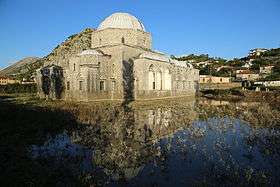Lead Mosque, Shkodër
| Lead Mosque | |
|---|---|
|
Flooded area of the mosque. | |
| Basic information | |
| Location | Shkodër, Albania |
| Geographic coordinates | 42°02′47″N 19°29′58″E / 42.0465°N 19.4995°ECoordinates: 42°02′47″N 19°29′58″E / 42.0465°N 19.4995°E |
| Status | Preserved |
| Architectural description | |
| Completed | 1773 |


The Lead Mosque (Albanian: Xhamia e Plumbit), also known as the Buşatlı Mehmet Pasha Mosque, is a historical mosque in Shkodër, northwestern Albania. It is located on a small lake and is not functional.
It took the name Lead Mosque, because all of its cupolas were covered with lead.[1]
History
The Lead Mosque was built in 1773 by the Albanian pasha Mehmed Bushati of the noble Bushati family, who was vizier of Pashalik of Scutari at the time.[2] Through this act, he intended to give his city of birth, the feeling of the capital.[3] It is said that the mosque's edifice was built on land owned by the catholic church.[4]
Mehmed Bushati was personally involved with the construction and stones were incised under his patronage. Almost every day, he stepped down from his residence, the Rozafa Castle, to follow the progress of the works.[1]
The first Imam of the mosque was Haxhi Ahmet Misria, who was of Egyptian origin. He came to Albania after the contacts he had with Mehmed Bushati. After him, other Imams served and also took care of the mosque.[1]
Damages
During the 1900's, the mosque begun to be damaged and the lead that covered the cupolas was gradually stolen. In 1916, the remaining lead was removed by the Austrian army during the Austrian rule in Albania.[1]
In 1967, lightning destroyed its minaret, which had been previously reconstructed in 1920 by Xhelal Bushati, descendant of Mehmed Bushati.[5]
State atheism
In 1967, Lead Mosque was closed down, just like the other religious institutions, after the anti-religious communist leader Enver Hoxha declared Albania an atheist state. Unlike many mosques that were destroyed during this time, it survived from the communist regime, probably because it was declared a Cultural Monument in 1948.[1][2][5]
Post-Communism
On 16 November 1990, the Lead Mosque preceded other mosques in Albania to reopen when religion was again allowed in the country. The very first religious rally was held in this mosque by Hafiz Sabri Koçi, after 23 years of state atheism.[1]
Construction
The Lead Mosque has an Ottoman architecture, unlike most other mosques in Albania which follow an Arab architecture.[2] It closely mirrors the classical Ottoman architecture of Istanbul, Turkey, which was pioneered by architect Mimar Sinan of the 16th century.[3]
The mosque is built with hewn stones of almost the same size, which creates a pleasant construction symmetry. Stones were brought from the nearby village of Gur i Zi by people who aligned to each other over kilometers passing the stones to reach the construction point.[1]
Restoration
The mosque has been repaired numerous times during its lifetime: in 1863, 1920 and in 1963.[2]
Gallery
References
- 1 2 3 4 5 6 7 Mirsad Sylja (20 August 2008). "Si po shkatërrohet "Xhamia e Plumbit", pasuria mbi 100-vjeçare" (in Albanian). peshku pa uje. Retrieved 23 July 2010.
- 1 2 3 4 Anila Dushi (22 July 2008). "Xhamia e plumbit po kalbet" (in Albanian). Shekulli. Retrieved 23 July 2010.
- 1 2 "KATOLIKËT RESTAUROJNË XHAMINE E PLUMBIT" (in Albanian). Pajtimi. Retrieved 23 July 2010.
- ↑ Willy Kamsi (16 November 1999). "Kisha e Kuvende të Shkodrës me Rrethina në Mesjetë" (in Albanian). Konferenca Ipeshkvnore e Shqipërisë, 2000.
Gjithashtu, simbas gojëdhanës, vendi ku âsht ndërtue xhamia e Plumbit, mendohet të ketë qenë truelli i nji kishe. «Dhe kjo nuk do të na çudisë, shton Cordignano, sepse dihet zakoni që kishin Turqit për me i shndrrue në xhamia vendet kushtue kultit të krishtenë».
- 1 2 "Xhamia e Plumbit" (in Albanian). Shkoder.net. September 1999. Retrieved 23 July 2010.
External links
| Wikimedia Commons has media related to Lead Mosque Shkodër. |
- Lead Mosque at Shkoder.net
